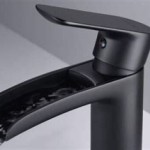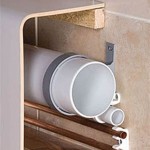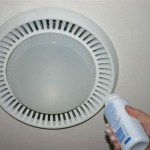Bathroom Cabinets and Sinks: Maximizing Space in Small Bathrooms
Small bathrooms present unique design challenges. Limited square footage necessitates careful planning and selection of fixtures that maximize functionality without sacrificing aesthetics. Bathroom cabinets and sinks are central to this equation, offering both storage and a focal point for the room. Choosing the right size, style, and configuration is crucial for creating a comfortable and efficient space.
This article explores various options for bathroom cabinets and sinks specifically tailored for small bathrooms, highlighting key considerations and providing guidance for making informed choices. It covers different mounting styles, materials, storage solutions, and design considerations to optimize space and enhance the overall functionality of a compact bathroom.
Wall-Mounted Vanities: Creating the Illusion of Space
Wall-mounted vanities, also known as floating vanities, are a highly effective choice for small bathrooms. By suspending the cabinet above the floor, they create an open space beneath, giving the illusion of a larger room. This visual trick can significantly improve the perceived size and airiness of the bathroom.
Furthermore, the open space under a wall-mounted vanity provides a convenient area for storing smaller items like baskets, scales, or cleaning supplies. This keeps essential items readily accessible without cluttering the limited floor space. The height of the vanity can also be adjusted during installation to suit individual needs and preferences, ensuring ergonomic comfort.
When selecting a wall-mounted vanity, carefully consider the weight-bearing capacity of the wall. Adequate reinforcement may be required, especially if the vanity is made of heavier materials or will be supporting a heavy countertop and sink. Consulting with a professional contractor is recommended to ensure proper installation and prevent future structural issues.
The design options for wall-mounted vanities are extensive, ranging from minimalist floating shelves to more substantial cabinets with drawers and doors. Opting for light colors and streamlined designs will further enhance the sense of spaciousness in the bathroom. Consider incorporating integrated lighting beneath the vanity to highlight the open space and add a touch of sophistication.
The sink options for wall-mounted vanities are varied. Vessel sinks, which sit atop the countertop, can add a stylish and modern touch. However, they also require more countertop space. Undermount sinks, which are installed beneath the countertop, offer a seamless and easy-to-clean surface. Integrated sinks, which are molded directly into the countertop, provide a sleek and contemporary look while minimizing seams and crevices.
Corner Vanities: Utilizing Often-Overlooked Space
Corner vanities are designed to fit snugly into the corner of a bathroom, maximizing the utilization of what is often considered unusable space. This is particularly beneficial in small bathrooms where every inch counts. By tucking the vanity into a corner, it frees up valuable floor space in the center of the room, making it feel less cramped.
Corner vanities come in various shapes and sizes, including triangular, curved, and rectangular designs. The choice depends on the specific configuration of the bathroom and the desired aesthetic. Triangular corner vanities are a popular option, offering a compact and symmetrical design. Curved corner vanities can add a softer, more organic feel to the bathroom. Rectangular corner vanities provide a more traditional and structured look.
Storage options for corner vanities can be limited due to their unique shape. However, many corner vanities feature a combination of drawers and doors, providing ample space for toiletries, cleaning supplies, and other bathroom essentials. Consider incorporating adjustable shelves to customize the storage space to your specific needs.
When installing a corner vanity, ensure that there is sufficient space to comfortably access the sink and cabinet. Consider the placement of other fixtures, such as the toilet and shower, to avoid overcrowding. Adequate lighting is also essential to illuminate the corner area and make it feel more inviting.
Sink options for corner vanities are similar to those for standard vanities, including vessel sinks, undermount sinks, and integrated sinks. The choice depends on the size and shape of the corner vanity and the desired style. Smaller sinks are generally recommended for corner vanities to maximize countertop space and prevent them from overwhelming the corner.
Pedestal Sinks: A Classic Space-Saving Solution
Pedestal sinks are a classic and timeless choice for small bathrooms. They consist of a sink basin mounted on a single pedestal base, offering a minimalist and space-saving design. Pedestal sinks are particularly well-suited for bathrooms where storage is not a primary concern, as they typically do not offer any built-in storage.
The primary advantage of pedestal sinks is their compact size and simple design. They take up minimal floor space, making them ideal for very small bathrooms or powder rooms. The clean lines and uncluttered appearance of pedestal sinks can also contribute to a more open and airy feel.
While pedestal sinks lack built-in storage, there are several ways to compensate for this. Wall-mounted shelves, medicine cabinets, and over-the-toilet storage units can provide additional storage space without taking up valuable floor space. Decorative baskets can also be placed near the pedestal sink to hold towels, soaps, and other essentials.
Pedestal sinks come in a variety of styles, from traditional to contemporary. Traditional pedestal sinks often feature ornate detailing and classic shapes. Contemporary pedestal sinks tend to have clean lines and minimalist designs. The choice depends on the overall aesthetic of the bathroom and personal preferences.
When selecting a pedestal sink, consider the height of the pedestal. Most pedestal sinks are designed to be a standard height of around 32 to 34 inches, but taller or shorter pedestals may be available to accommodate individual needs. Ensure that the pedestal is securely attached to the floor and that the sink basin is properly sealed to prevent leaks.
Faucet options for pedestal sinks are typically wall-mounted or deck-mounted. Wall-mounted faucets offer a clean and minimalist look, while deck-mounted faucets are more traditional and versatile. Choose a faucet style that complements the design of the pedestal sink and the overall bathroom aesthetic.
Materials and Finishes: Enhancing Durability and Style
The materials and finishes used for bathroom cabinets and sinks play a crucial role in both their durability and their overall aesthetic appeal. Choosing the right materials can ensure that the fixtures withstand the moisture and humidity of the bathroom environment while also complementing the desired design style.
For bathroom cabinets, common materials include wood, plywood, MDF (medium-density fiberboard), and particleboard. Solid wood is the most durable and aesthetically pleasing option, but it is also the most expensive. Plywood is a good alternative, offering a combination of strength and affordability. MDF and particleboard are less expensive options, but they are also more susceptible to moisture damage.
The finishes used on bathroom cabinets can significantly impact their appearance and durability. Painted finishes are a popular choice, offering a wide range of color options and a smooth, easy-to-clean surface. Stained finishes highlight the natural grain of the wood and provide a more traditional look. Laminate finishes are a cost-effective option that can mimic the look of wood or other materials.
For bathroom sinks, common materials include porcelain, vitreous china, fireclay, glass, and stainless steel. Porcelain and vitreous china are the most popular choices, offering a combination of durability, affordability, and ease of cleaning. Fireclay is a more durable and luxurious option, known for its resistance to scratches and stains. Glass sinks can add a modern and elegant touch, but they require more careful cleaning. Stainless steel sinks are durable and easy to clean, but they can sometimes feel cold and sterile.
The finishes used on bathroom sinks can also impact their appearance and durability. Porcelain and vitreous china sinks are typically finished with a glossy glaze that protects the surface and makes it easy to clean. Fireclay sinks are often finished with a matte or satin glaze that provides a more subtle and sophisticated look. Glass sinks can be clear, frosted, or colored, depending on the desired aesthetic. Stainless steel sinks are typically finished with a brushed or polished surface that resists scratches and fingerprints.
When selecting materials and finishes for bathroom cabinets and sinks, consider the overall style of the bathroom and the desired level of durability. Choose materials that are resistant to moisture and humidity, and finishes that are easy to clean and maintain. Investing in high-quality materials and finishes will ensure that the fixtures last for many years to come and maintain their beauty and functionality.
Utilizing Vertical Space for Storage
In small bathrooms, maximizing vertical space is essential for optimizing storage. Instead of focusing solely on floor-level cabinets and sinks, consider incorporating storage solutions that extend upwards, making use of the often-overlooked wall space. This approach can significantly increase storage capacity without taking up valuable floor area.
Tall, narrow cabinets are an excellent option for utilizing vertical space. These cabinets can be placed next to the vanity, above the toilet, or in any other available corner. They can provide ample storage for towels, toiletries, cleaning supplies, and other bathroom essentials. Look for cabinets with adjustable shelves to customize the storage space to your specific needs.
Wall-mounted shelves are another versatile option for utilizing vertical space. They can be installed above the vanity, above the toilet, or along any available wall. Wall-mounted shelves can be used to display decorative items, store toiletries, or hold folded towels. Choose shelves that are made of durable materials and that can support the weight of the items being stored.
Medicine cabinets are a classic and practical addition to any bathroom, especially small ones. They provide a convenient place to store medications, toiletries, and other personal care items. Medicine cabinets can be recessed into the wall for a flush and seamless look, or they can be surface-mounted for easy installation.
Over-the-toilet storage units are designed to fit snugly over the toilet, providing additional storage space without taking up valuable floor area. These units typically feature a combination of shelves and cabinets, offering ample space for storing toiletries, towels, and other bathroom essentials. Choose an over-the-toilet storage unit that is sturdy and stable, and that complements the overall design of the bathroom.
Hooks and racks are a simple and effective way to utilize vertical space for hanging towels, robes, and other items. Install hooks and racks on the back of the door, on the walls, or inside cabinets to maximize space. Choose hooks and racks that are made of durable materials and that can support the weight of the items being hung.

Bathroom Vanity Styles To Fit Your Space Forbes Home

Wall Mounted Bathroom Cabinet Ideas Designcafe

Modern Bathroom Vanity Design Regalo Kitchens

Beautiful Bathroom Vanity Ideas Forbes Home

25 Single Sink Bathroom Vanity Design Ideas

Bathroom Vanity Ideas The Home Depot

15 Small Bathroom Vanity Ideas That Rock Style And Storage

11 Exquisite Bathroom Vanity Designs

The Best 19 Small Bathroom Vanities Of 2024

Wash Basin Cabinet Furniture Designs Vanity Washbasin Design Bathroom Cabinets Small Sinks
Related Posts







